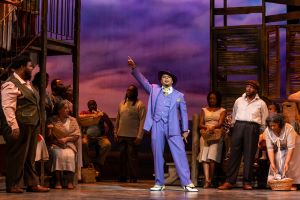For the last production of the 2022-2023 season, North Carolina Opera‘s Porgy & Bess welcomes audiences to experience an epic story of pain, deep love, forgiveness, and new life. As rain and potential thunderstorms loomed over Raleigh on Friday night, audiences were given an ominous glimpse into what was to come on Catfish Row.
The three-hour production is performing at the newly named Martin Marietta Center for the Performing Arts (long known as the Duke Energy Center for the Performing Arts). All around and within the building’s Greek-inspired architecture were people of all ages, races, and classes. Even North Carolina Governor Roy Cooper was spotted in the audience and given a long strand of applause prior to the start of the show. It was truly refreshing to see so many people devoted to Triangle arts and eager to witness the greatness that is classic opera.
Debuting in Boston in 1935, Porgy and Bess tells the unlikely, tragic love story of Porgy (Kenneth Overton), a crippled beggar, and Bess (Nicole Cabell), the town’s lonely floozie. Originally based on the novel Porgy by DuBose Heyward, the opera was composed and written by classic American composer George Gershwin. Considered one of the first great American operas, Porgy and Bess has won Tony and Grammy awards, and perhaps best known for its numbers “Summertime” and “I Got Plenty O’ Nuttin’.”
As the curtains opened, the audience was transported back in time to 1920s Catfish Row, a predominantly Black neighborhood in Charleston, South Carolina. A hot and humid summer day, in a neighborhood with no riches, Diana Thompson-Brewer (Clara) sang out the famous melody of “Summertime.” The neighborhood is riddled with gambling and substance addiction over a dice game of craps, but we find some relief when we meet the soon-to-be lovers, Porgy and Bess. These two main characters are seemingly nothing alike, though they are quick to find comfort in each other’s presence, seeking stability and love from each other and their community after having been outcast and shunned by many.
One of the most impressive elements of the show was the lighting (designed by Michael Baumgarten), which clearly was orchestrated with intentionality and delivered with purpose, cueing the audience to the time of day between each scene. Yellows, pinks, reds, purples, blues, and greens were displayed to represent sunrise, sunset, and any impending danger in the weather. The lighting design delighted throughout the production, and the production was all the more successful for it. Contrasting the elaborate lights, the stage’s set (designed by John Farrell) was minimal but provided a look into the poor neighborhood with the use of broken windows, stairs, and roofs.
As Act II began, the audience was filled with the pain of local resident Robbins’ (Elliott Brown) death, but hopeful for the relationship between Porgy and Bess that is beginning to blossom. The story then transports us to Kittawa Island, where men and women are picnicking with their children. The character Sportin’ Life (Victor Ryan Robertson) sings “It Ain’t Necessarily So,” which gives a small bit of comedic relief. This relief is quickly stolen from us as Bess becomes forced to stay on the island with Crown (Donovan Singletary) until she can escape back to Catfish Row two days later. But relief returns once more when Bess and Porgy are able to embrace and reaffirm their love in “I Loves You Porgy.”
Additional standout performances included those by Michelle Johnson (Serena), Lucia Bradford (Maria), and Jared Payton (Crab Man). True to her character, who acts as the main support person for the neighborhood, Johnson anchored the show, vocally and performance-wise, while Payton provided a bit of comic relief as Crab Man attempts to sell devil crabs to a heedless crowd. This weekend’s production even includes that of Elvira Green, who performed in the very first production of Porgy and Bess at the Metropolitan Opera in 1985.
Without giving much away, the neighborhood continues to experience grief. New faces emerge as others are torn from the community altogether. Porgy must decide if he wants to leave his home or stay, but, ultimately, he decides to leave in search of the one person who truly understood him. The audience is grateful for this decision and cheers along, but we are left with a bit of a cliffhanger. Does Porgy make it out of Catfish Row safely? Does his love for Bess last a lifetime?
No matter class, age, race, or gender, the people of Raleigh were brought together to experience the classic love story that is Porgy and Bess. As the audience stepped foot out of the theater, they left 1920s Catfish Row behind.
This show is commonly met with criticism saying that Gershwin stereotyped Black people, as many of the story’s key themes revolve around violence, drinking, gambling, and drug dealing/addiction. Even though these criticisms are extremely valid and noticeable, they do not take away from the story and the message in Ira Gershwin‘s lyrics that no matter how hard we try, our lives are filled with both the lingering fear of death and love. Both must exist, but we can decide if they will bring communities together or tear them apart. Amidst adversity, the power of love will always remain true.
NC Opera’s production of Porgy and Bess continues through Sunday, April 16. For more details on this production, please view the sidebar.











